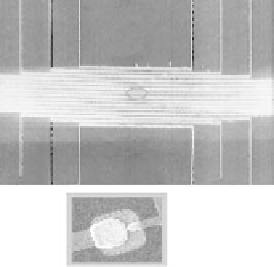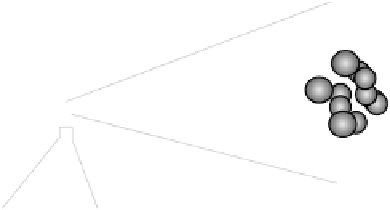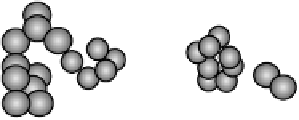Biomedical Engineering Reference
In-Depth Information
(b)
(a)
Deposition
Electron tunneling
3
(c)
2
1
Monitor current
0
−
1
0
2
4
5
Time (s)
FIGURE 4.7
Fabrication of nanoelectrode arrays. (a) Scanning electron microscopy image of an array of Au electrode pairs on
an oxidized Si chip. The inset shows a pair of electrodes (a big and a small one) separated with a gap of a few
nm. (b) The gap between the electrodes in each pair decreases as one electrochemically deposits atoms onto the
electrodes, and the process is monitored by the current across the gap. (c) When the gap is reduced to a few
nanometers, electron tunneling takes place between the electrodes. The tunneling current increases in discrete
steps, reflecting the discrete nature of atoms. Adapted from Li, C. Z., He, H. X., Tao, N. J. (2000). Quantized
tunneling current in the metallic nanogaps formed by electrodeposition and etching.
Appl. Phys. Lett
. 77:
3995-3997. With permission.
tunneling effect
(
Figure 4.7c
)
. Because the tunneling current is extremely sensitive to the gap
width, the width can be controlled using the tunneling current as a feedback signal.
Subsequently, taking advantage of the reversibility of the electrochemical process, Au atoms
are etched away from the electrodes to enlarge the gap to desired dimension. Once the nano-
electrodes separated with nanometer-scale gaps are fabricated, the gaps are bridged with CPs
(e.g., PANI and PPY) to form nanojunctions by cycling the potential of the nanoelectrodes in
a solution containing monomer
(
Figure 4.8
)
[41]. The potential cycling converts the
monomers into polymers and deposits the polymers into the gap. A controlled amount of
polymers is deposited in the gap by controlling the cycling time. Unlike the nanowires pro-
duced using preformed channel, the length to width ratio of the nanojunction is not well
controlled and the aspect ratio is small. However, since the conductance path defined by the
separation between the electrodes is small, this nanojunction approach is particularly suitable
for polymers that are poorly conductive under physiological conditions, or polymers that lose
much of their conductivity upon attachment of receptor groups.
4.3
Functionalization of Conducting Polymers
Most of the research in the functionalization of CPs has been based on thin-films. However,
the same techniques should also be applicable in the functionalization of CP NWs. Various
functional groups can be immobilized within the CPs matrix inducing specific properties in






























